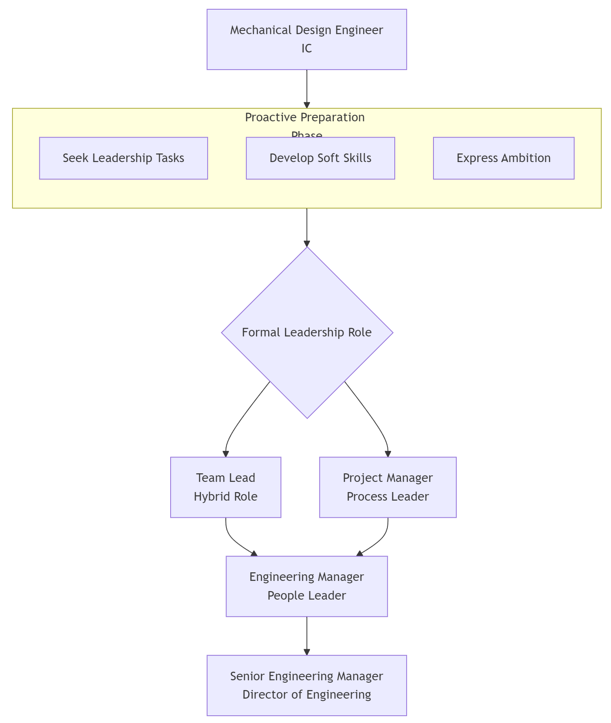
Excellent question. Transitioning from a Mechanical Design Engineer to an Engineering Manager is one of the most significant and rewarding leaps you can make in your career. It’s a fundamental shift from being a technical individual contributor to a people and project leader.
Here’s a comprehensive guide to making that leap successfully.
The Fundamental Mindset Shift-:
First, understand that this is not just a promotion; it’s a career change. Your core responsibilities and measures of success change dramatically.
| From: Mechanical Design Engineer (Individual Contributor) | To: Engineering Manager (People & Process Leader) |
|---|---|
| Success through your own work. You are the “doer.” | Success through your team’s work. You are the “enabler.” |
| Technical Depth. You are the expert on your specific design or subsystem. | Technical Breadth. You understand enough to guide, review, and make decisions across multiple projects. |
| Focus on “What” and “How.” What needs to be designed and how to make it work. | Focus on “Why” and “Who.” Why are we doing this project and who is best suited for each task. |
| Direct Control. You have direct control over your tasks and output. | Influence & Delegation. You achieve goals by motivating, coaching, and delegating to others. |
The Core Competencies You Need to Develop-:
To prepare for and succeed in a management role, focus on building these key areas:
1. People Leadership & Emotional Intelligence-:
This is the single most important skill set.
-
Mentorship & Coaching: Start by informally mentoring junior engineers. Can you help them debug a problem without taking over the keyboard?
-
Constructive Feedback: Learn to deliver feedback that is specific, actionable, and kind. It should help the engineer grow, not just criticize.
-
Conflict Resolution: Teams are made of people, and people have disagreements. You need to be the calm mediator who finds a productive path forward.
-
Motivation & Empowerment: Understand what drives each of your team members. Your job is to remove roadblocks and create an environment where they can do their best work.
2. Project & Portfolio Management-:
You’re no longer just responsible for your tasks, but for the entire project’s success.
-
Scope & Timeline Management: Develop the ability to create realistic project plans, set milestones, and manage resources.
-
Risk Management: Proactively identify potential technical, schedule, or resource risks and develop mitigation plans.
-
Budgeting & Resource Allocation: Learn how to build a budget for a project and make smart decisions about hiring, tools, and equipment.
3. Strategic Communication-:
Your audience expands significantly.
-
Upward Communication: You must clearly communicate project status, risks, and team needs to senior management and stakeholders.
-
Cross-Functional Communication: You become the liaison between your engineering team and other departments like Marketing, Sales, Finance, and Manufacturing.
-
Running Effective Meetings: Learn to facilitate meetings with clear agendas and outcomes, rather than just participating in them.
4. Strategic Thinking-:
You shift from executing a plan to helping define it.
-
Business Acumen: Understand why a project is important. How does it align with the company’s business goals, market position, and financial objectives?
-
Decision-Making: You’ll be making tough calls with incomplete information, often weighing technical perfection against business constraints like cost and time.
A Practical Roadmap for Making the Leap-:

1. Excel as a Senior Engineer:
-
Become the “go-to” person for a critical domain. You can’t lead if you don’t have strong technical credibility.
-
Start demonstrating leadership before you have the title.
2. Be Proactive and Seek Responsibility:
-
Volunteer to Lead: Offer to lead a small project, a design review, or a process improvement initiative.
-
Mentor Junior Engineers: This is the most direct way to show your aptitude for people development.
-
Delegate (Upwards): When your plate is full, don’t just say “no.” Go to your manager and say, “I can take this new task, but which of these other priorities should I de-prioritize, or can we assign to someone else?” This shows resource management thinking.
3. Develop Your Skills intentionally:
-
Find a Mentor: Seek out a current engineering manager you respect. Ask them about their challenges and what they wish they knew before starting.
-
Formal Training: Ask your company to sponsor courses on project management (PMP), leadership, or finance.
-
Read Widely: Go beyond technical manuals. Read books on management, leadership, and psychology (e.g., The Making of a Manager by Julie Zhuo, Radical Candor by Kim Scott).
4. Communicate Your Ambition:
-
Have the Conversation: Don’t assume your manager knows your goals. Schedule a dedicated career discussion and explicitly state, “My long-term goal is to move into an engineering management role.”
-
Ask for a Development Plan: Work with your manager to create a plan that includes opportunities to practice the skills listed above.
The Challenges to Anticipate:
-
Letting Go of Technical Work: This is often the hardest part. You may miss the deep, hands-on problem-solving. You have to find satisfaction in the success of your team.
-
The “Player-Coach” Trap: Many start as a Team Lead, juggling both individual work and management duties. This is a tough balance and can lead to burnout if not managed carefully.
-
Dealing with Underperformance: Holding people accountable and managing performance issues is emotionally draining and one of the most challenging aspects of the job.
Conclusion
The path from Mechanical Design Engineer to Engineering Manager is a journey of personal growth. It’s about expanding your impact from a single component to an entire team and its output. By intentionally developing your people skills, business acumen, and strategic thinking while you’re still an individual contributor, you can position yourself as the ideal candidate when a leadership opportunity arises and make a successful, rewarding leap.
“Thank you for reading! If you found this article insightful and valuable, consider sharing it with your friends and followers on social media. Your share can help others discover this content too. Let’s spread knowledge together. Your support is greatly appreciated!”

